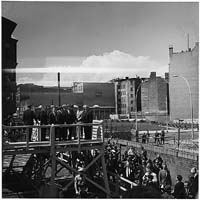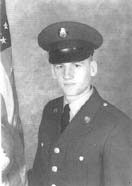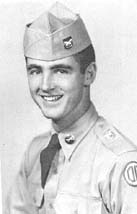Home → Corporations, Elections & Commissions → Elections & Voting → Voter Information → Vote in Honor of a Veteran → Table of Contents → Berlin Wall
Berlin Wall (1969-1970) |
|
At the end of World War II, the city of Berlin was partitioned into East and West Berlin. West Berlin was occupied by British, French, and United States forces and supported by the Federal Republic of Germany, usually known as West Germany. After this division, millions of people fled East Germany, many through Berlin, in order to have a higher standard of living. Beginning in August of 1961, East Germany, identified as the German Democratic Republic (GDR), began to block off East Berlin from West Berlin with barbed wire and anti-tank obstacles. Tanks were stationed at crucial places, and subway lines and rail service between the two were interrupted. In the following days the temporary barriers were replaced by a solid wall. The GDR called the wall protection from military aggression and political interference, but the western allies considered it a violation of Berliners' right to self-determination. The Berlin Wall became a symbol of the Cold War tensions between the USSR and her communist allies and the western allies, led by the United States. The concrete wall was 12 feet high and 103 miles long. It cut through 192 streets, 97 leading to East Berlin and 92 into the GDR. Before its destruction, as many as 100 people may have been killed at the wall.
|
|
|
|
|
|
|
|
Wives respectfully honor husbands who were stationed in Germany during this period: |
|
|
|
|
|
|
|
|
|
The Fall During the summer of 1989, Hungary allowed East Germans to pass through Hungary on their way through to Austria and West Germany. By fall the East German regime had lost its power. On November 9, private citizens began to destroy entire sections of the concrete wall that had divided the city of Berlin for nearly 30 years. On November 22, new passages were opened north and south of the Brandenburg Gate, eliminating the separation that had divided the people of Germany since the end of World War II. On July 1, 1990, an economic, monetary, and social union between East and West Germany is formed, and all travel restrictions are eliminated. The two Germany's are reunited as the Federal Republic of Germany. Today a museum stands near the most famous crossing point, "Checkpoint Charlie," of what once was the infamous Berlin Wall. |
|
Additional Tributes Submitted OnlineTribute to my husband, Lucien Belanger: |
|


